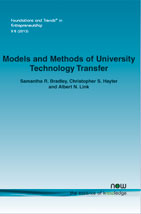Models and Methods of University Technology Transfer
By Samantha R. Bradley, Department of Economics, University of North Carolina at Greensboro, USA, srbradle@uncg.edu | Christopher S. Hayter, Executive Director, Policy Evaluation and Transformation, New York Academy of Sciences, USA, chayter@nyas.org | Albert N. Link, Department of Economics, University of North Carolina at Greensboro, USA, anlink@uncg.edu
Abstract
This monograph argues that a linear model of technology transfer is no longer sufficient, or perhaps even no longer relevant, to account for the nuances and complexities of the technology transfer process that characterizes the ongoing commercialization activities of universities. Shortcomings of the traditional linear model of technology transfer include inaccuracies — such as its strict linearity and oversimplification of the process, composition, a one-size-fits-all approach, and an overemphasis on patents — and inadequacies — such as failing to account for informal mechanisms of technology transfer, failing to acknowledge the impact of organizational culture, and failing to represent university reward systems within the model. As such, alternative views of technology transfer that better capture the progression of the university toward an entrepreneurial and dynamic institution are presented here, and that advance the body of knowledge about this important academic endeavor.
Models and Methods of University Technology Transfer
Models and Methods of University Technology Transfer covers the rise of university technology transfer since the 1980's, as well as the economic and academic benefits that stem from the commercialization of university-discovered technologies. Currently, most literature on university technology transfer focuses on institutions that facilitate commercialization, and models that oversimplify the technology transfer process by assuming that the knowledge flow is linear. Models and Methods of University Technology Transfer reviews existing literature regarding university technology transfer in terms of the process within the traditional linear model. After an address of the limitations of the traditional model, alternatives conceptualizations of technology transfer are presented in order to more accurately illustrate university technology transfer in practice.
